
|
by Derek Johnson
| |||||||
|
[Editor's Note: Here you will find the other Watching the Future columns.]
When I got them home and began to explore the world they presented, those two comics blew my sixteen-year-old mind.
I say The Incal was my first conscious encounter to Moebius because he made me receptive to his work prior to losing myself in the color pages of those panels through four science fiction movies that had shaped so much of no only my own imagination but also those of most of my generation. Though he did not contribute to two of them directly, he had a hand in two others, and heavily influenced a fifth released as I entered my third decade. Moebius, of course, worked on movies before. He turned in a good deal of artwork to Jodorowsky during his failed attempt to bring Frank Herbert's Dune to the screen in the 1970s, creating character sketches of Paul Atreides, Lady Jessica, Piter De Vries, and Baron Vladimir Harkonnen so perverse and conceiving of scenes so insanely dreamlike that they must have sent Herbert into a frothing rage. However, I wouldn't see these until the late 1990s. No, my first exposure came through Ridley Scott's Alien. When I first saw this groundbreaking movie, my knowledge of science fiction and horror came through either classic Victorian titles (Dracula by Bram Stoker, The Strange Case of Dr. Jekyll and Mr. Hyde by Robert Louis Stevenson, The Time Machine by H.G. Wells) or a myriad sampling of movies and television, from Star Wars and Close Encounters of the Third Kind to Star Trek in syndication and the occasional Hammer picture playing on Saturday afternoon. Though I approached some of these works for their ideas, the design elements drove me to the movies. I may not have believed in them—those clean white surfaces in Sleeper, for example, seemed far too unreal and strange to my lower-middle-class brain—but they were different, and different was what I needed.
And man, was Alien different. The pipes on the Nostromo, the padded hallway leading to Mother, the tubing and textured walls of the cockpit, the hissing ducts... these were a far cry from the clean, partitioned corridors of the U.S.S. Enterprise. Harry Dean Stanton's Hawaiian shirt and Yaphet Kotto's sneakers pushed me into a palpable realm of cognitive dissonance. I didn't know it at the time, but this was part of Moebius's world.
But it was the polluted Los Angeles of Bladerunner that borrowed most heavily from The Long Tomorrow. I've written of my love for that particular picture in a previous column, but at the time had absolutely no idea that The Long Tomorrow provided Ridley Scott and his team of art directors the necessary vision to bring that future to life. My jaw dropped when I compared the hallway Pete Club's ratty apartment with the foyer to Rick Deckard's condo. Like Michaelangelo, where Ridley Scott stole, he left his knife.
And then there was Tron. Here is a movie that seemed the most odd in a summer brimful with science fiction, and it was in part because of the Day-Glo piping of the programs' suits, as well as the menacing contours of Sark's helmet. True, in 1982 I was more fascinated by Deckard's gun and trench coat, but the design of Tron's lightsail also filled me with no small amount of wonder.
By the end of 1982 my interest in science fiction movies waned. I was reading Heavy Metal and borrowing a friend's issues of Judge Dredd on a pretty regular basis, and the visual elements of science fiction movies simply weren't providing the proper frisson. Other movies flickered through cineplexes, but they seemed like afterthoughts at best, pale imitations of genius at worst. In addition, the pages of Omni and work by the likes of such diverse talents as Bruce Sterling and Connie Willis in The Magazine of Fantasy and Science Fiction provided the sense of wonder and eyeball kicks movies held back. I still loved movies, but became convinced that I wouldn't find the same level of artistry I had seen then, and was witnessing when I picked up The Incal.
It's been more than thirty years, but whenever I think of the visual import of science fiction, it is Moebius, either directly or indirectly, I think of. His was one of the most singular talents to grace the field, and will be missed. | |||||||
|
Derek Johnson's critical work has appeared on SF Site, SF Signal, and Revolution SF. His first novel, the erotic thriller, Murder, Most Likely, written in collaboration with SammyJo Hunt, is forthcoming from Rebel Ink Press. He lives in Central Texas with the Goddess. |
|
|
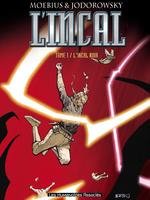
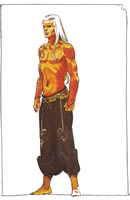
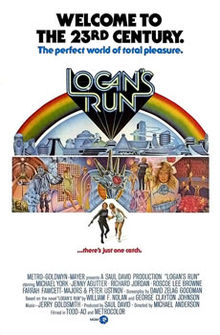 At the time, Philip K. Dick's twisted metaphysical skiffy novels were rewiring my brain
in ways that my parents I'm sure found distressing (though my father, a Lutheran minister,
perhaps welcomed any attempt to discuss philosophy with me, even if it was steeped in the
trash trappings from Dick's warped cerebellum), so Jodorowsky's mixture of space opera and
metaphysics found itself completely at home in my head. Moebius's artwork, however, added
detail and substance to an adolescent imagination already deeply informed by the William
Gibson of "Johnny Mnemonic" and "Burning Chrome." Yes, I was familiar with the science
fictional cities presented in movies such as Logan's Run and The Empire Strikes Back,
but the streets and alleys of The Incal's capitol city felt like
lived-in spaces. They breathed. So of course I was immediately hooked.
At the time, Philip K. Dick's twisted metaphysical skiffy novels were rewiring my brain
in ways that my parents I'm sure found distressing (though my father, a Lutheran minister,
perhaps welcomed any attempt to discuss philosophy with me, even if it was steeped in the
trash trappings from Dick's warped cerebellum), so Jodorowsky's mixture of space opera and
metaphysics found itself completely at home in my head. Moebius's artwork, however, added
detail and substance to an adolescent imagination already deeply informed by the William
Gibson of "Johnny Mnemonic" and "Burning Chrome." Yes, I was familiar with the science
fictional cities presented in movies such as Logan's Run and The Empire Strikes Back,
but the streets and alleys of The Incal's capitol city felt like
lived-in spaces. They breathed. So of course I was immediately hooked.

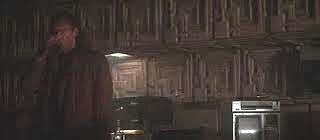 It happened again with The Empire Strikes Back and Bladerunner. Moebius worked
on neither of these movies, but his work on the Dan O'Bannon comic The Long Tomorrow
inspired elements of design for both. Indeed, the probe droid at the beginning of
The Empire Strikes Back seems practically lifted from his brush, as it closely resembles
a robotic sentinel on a spaceport launch pad from O'Bannon's story.
It happened again with The Empire Strikes Back and Bladerunner. Moebius worked
on neither of these movies, but his work on the Dan O'Bannon comic The Long Tomorrow
inspired elements of design for both. Indeed, the probe droid at the beginning of
The Empire Strikes Back seems practically lifted from his brush, as it closely resembles
a robotic sentinel on a spaceport launch pad from O'Bannon's story.
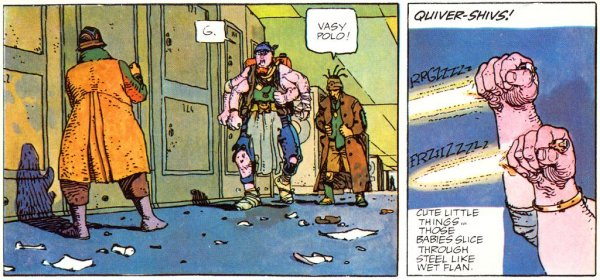
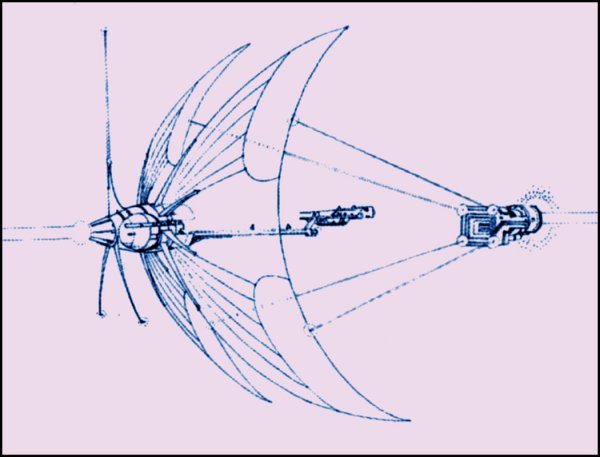

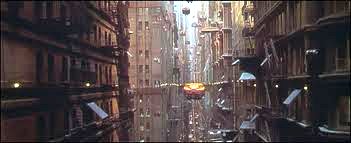 So when I saw The Fifth Element in 1997, I was completely surprised. Not only did it seem
like Luc Besson had taken its design and a few key concepts directly from Moebius (whose name, yes,
I now knew) and Jodorowsky, specifically from The Incal. (They saw similarities
too, and filed suit.) Did I mind? Perhaps somewhat, but I immediately felt twinges of nostalgia
and excitement that I thought had vanished in the early 1980s. Sure, Korben Dallas was more
cocksure and competent than John DiFool, but the New York cityscape and Rubi Rhod's
costuming appeared to come right out of those panels. So, apparently, did the loopy
metaphysics. I was home.
So when I saw The Fifth Element in 1997, I was completely surprised. Not only did it seem
like Luc Besson had taken its design and a few key concepts directly from Moebius (whose name, yes,
I now knew) and Jodorowsky, specifically from The Incal. (They saw similarities
too, and filed suit.) Did I mind? Perhaps somewhat, but I immediately felt twinges of nostalgia
and excitement that I thought had vanished in the early 1980s. Sure, Korben Dallas was more
cocksure and competent than John DiFool, but the New York cityscape and Rubi Rhod's
costuming appeared to come right out of those panels. So, apparently, did the loopy
metaphysics. I was home.